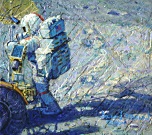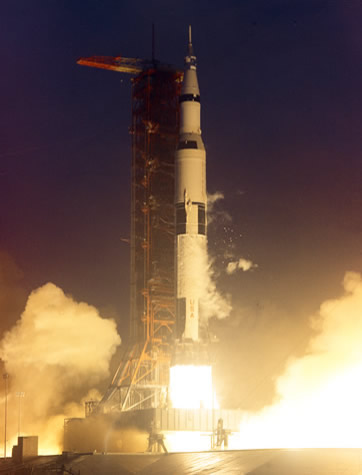
|
Godspeed, Alan Bean March 15, 1932 - May 26, 2018 
|

|
- Home
- Art of Another World
- Galleries
- Moonwalker & Astronaut
- About Alan Bean
- Available Paintings

|
We Flew on the Most Powerful Machine Ever Built
Our Saturn V rocket at lift off. I was surprised by the severity of the vibration when the engines started.
I had never been shaken so roughly. Lightning struck us about 36 seconds later,
taking the fuel cells, and most of the electrical power to the command module, offline.
Quick coordination with Mission Control allowed us to solve the problem, restore power,
and continue on into Earth orbit.
|
|
All photos courtesy of NASA.              
A double core tube is a two-meter-long hollow pipe with a sharp bit on the front. I drove it in as far as I could, pulled it out, removed the sharp bit and replaced it with a cap. Back on Earth, scientists cut the core tube lengthwise and exposed a cross-section of the lunar surface for detailed study. When I got back to Earth, I recommended this hammer be replaced with a much heavier one. NASA made the change to the hammer and driving core tubes was no longer a problem on future missions. Running Was Easier Than Walking in the 1/6th Gravity Running on the moon took less energy than walking on the moon. This was because it was easier for me to move my small ankle joints than to move my much larger hip and knee joints. As I ran about, I looked ahead so I did not step into any small craters or on any rocks and injure an ankle. Also, I could not move too close to larger craters because if the edge were to give away, I would slip into the crater and be up there a long, long time. Dancing on my tiptoes was the easiest way to move about and it was a lot of fun as well. Working on the Moon Inside My Space Suit Was Hard Work Near my right leg is our tool carrier with all the equipment that we would use to explore the moon. There is a hammer, a number of core tubes, sample bags, a scoop and a variety of other geological tools. You can see my cuff checklist and watch on my left arm. Pete is visible in my visor as he takes this portrait of me on the moon. Both legs are getting dirty with moondust. Holding a Sterile Container to Collect Pristine Moon Dust Some scientists on Earth were concerned that the moon rocks that Neil and Buzz picked up on Apollo 11 were contaminated by their gloves. To see if this was really a problem, we carried an environmental sample container on our mission. You can see that I am holding it in my right glove. Pete had just filled it with lunar material using only the scoop. I'm going to attach the lid that you can see hanging below the container without touching the inside or any of the material inside. Back on Earth, testing would reveal that we did not and would not contaminate moon rocks when we picked them up. Proof We Made a Pinpoint Landing Well, we made a successful pinpoint landing right on the edge of Surveyor Crater. Pete moved down to ensure that Surveyor 3 was stable and there was no danger it might slide further down into the crater. He is telling me that it's safe to come down to help him cut off the camera (we can see near his right shoulder), the scoop (near his left leg) and several other pieces that scientists on Earth were very interested in examining. You can see "Intrepid" on the far side of Surveyor Crater some 200 meters distant. The Moon Looked as Flat as It Looks on Your Screen I can remember how flat the moon looked to me as Pete, Dick and I headed back to Earth. We seemed to rise above a huge black and white photo of the moon and not above a sphere like it really is. We all know when we look at the moon from Earth that it does not look like a sphere. It looks flat because the lunar soil backscatters light equally from the center all the way out to the rim. It was a strange, beautiful and welcome sight as the three of us began our journey home in Yankee Clipper. |
Home |
Art of Another World |
Galleries |
Moonwalker & Astronaut |
About Alan Bean |
Available Paintings |
About this Site
Copyright © 2008-2025 by Alan Bean. All rights reserved.
Copyright © 2008-2025 by Alan Bean. All rights reserved.
